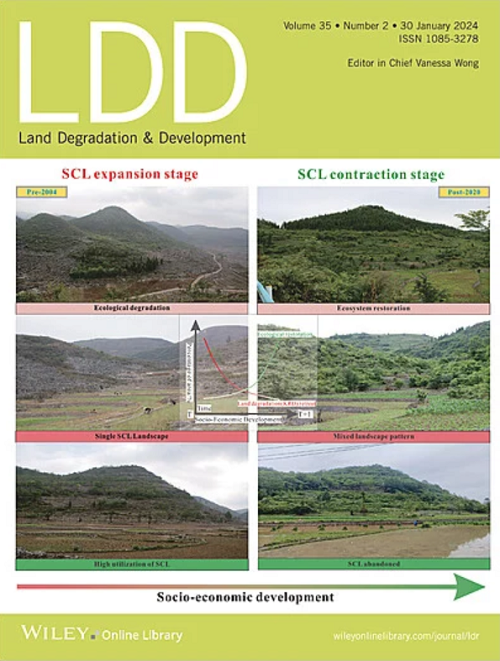收获蚁巢与废弃羊圈交互作用对半干旱牧场土壤养分动态和植被的影响
IF 3.6
2区 农林科学
Q2 ENVIRONMENTAL SCIENCES
引用次数: 0
摘要
内盖夫沙漠等半干旱地区由于降水少、土壤营养不良和放牧导致的土地退化而面临重大挑战。传统的放牧方式,特别是羊圈,创造了富含营养的热点,几十年来影响了土壤养分动态和植被模式。同时,收获蚁(Messor spp.)作为生态系统工程师,改变土壤性质和促进生物多样性。然而,蚁巢和废弃羊圈对土壤和植被影响的相互作用仍未得到充分研究。本研究评估了半干旱牧场收获蚁巢和废弃羊圈对土壤养分动态和植被特征的协同效应。使用析因实验设计,我们比较了四种处理组合:开放空间和围栏,有和没有蚁巢。测量的关键变量包括土壤性质(如pH值、电导率[EC]、硝酸盐、钾和钠的吸收比[SAR])、植被高度、生物量和物种组成。结果表明,在畜栏内的收获蚁巢显著降低了土壤盐分(降低了EC和SAR),并重新分配了钾,恢复了更接近露天牧场条件的土壤性质。植被变化明显,较高的谷物(Avena sterilis)在有蚁巢的开阔地区占主导地位,而营养丰富的畜栏则有利于嗜氮物种,如Chenopodium murale。尽管有这些变化,但不同处理间的植物生物量差异没有统计学意义。这些发现突出了将收获蚁整合到退化半干旱景观的生态恢复策略中的潜力。通过重新分配养分和种子,降低盐度,支持植物丰富度,收获蚁充当了自然恢复的代理人。这项研究强调了利用生物相互作用和传统放牧方式对半干旱地区可持续土地管理和生态系统恢复的重要性。本文章由计算机程序翻译,如有差异,请以英文原文为准。
Interactive Effects of Harvester Ant Nests and Abandoned Sheep Corrals on Soil Nutrient Dynamics and Vegetation in Semiarid Pastures
Semiarid regions like the Negev Desert face significant challenges due to low precipitation, nutrient-poor soils, and grazing-induced land degradation. Traditional grazing practices, particularly sheep corrals, have created nutrient-rich hotspots that have influenced soil nutrient dynamics and vegetation patterns for decades. Simultaneously, harvester ants (Messor spp.) act as ecosystem engineers, modifying soil properties and promoting biodiversity. However, the interplay between ant nests and abandoned sheep corrals in influencing soil and vegetation remains understudied. This study assessed the synergistic effects of harvester ant nests and abandoned sheep corrals on soil nutrient dynamics and vegetation characteristics in semiarid pastures. Using a factorial experimental design, we compared four treatment combinations: open spaces and corrals, with and without ant nests. Key variables measured included soil properties (e.g., pH, electrical conductivity [EC], nitrate, potassium, and sodium absorption ratio [SAR]), vegetation height, biomass, and species composition. Results revealed that harvester ant nests within corrals significantly mitigated salinity (reducing EC and SAR) and redistributed potassium, restoring soil properties closer to open-pasture conditions. Vegetation shifts were evident, with taller cereals (Avena sterilis) dominating open areas with ant nests, while nutrient-enriched corrals favored nitrophilous species such as Chenopodium murale. Despite these changes, plant biomass differences across treatments were not statistically significant. These findings highlight the potential of integrating harvester ants into ecological restoration strategies for degraded semiarid landscapes. By redistributing nutrients and seeds, reducing salinity, and supporting plant richness, harvester ants act as natural agents of restoration. This study underscores the importance of leveraging biotic interactions and traditional grazing practices for sustainable land management and ecosystem recovery in semiarid regions.
求助全文
通过发布文献求助,成功后即可免费获取论文全文。
去求助
来源期刊

Land Degradation & Development
农林科学-环境科学
CiteScore
7.70
自引率
8.50%
发文量
379
审稿时长
5.5 months
期刊介绍:
Land Degradation & Development is an international journal which seeks to promote rational study of the recognition, monitoring, control and rehabilitation of degradation in terrestrial environments. The journal focuses on:
- what land degradation is;
- what causes land degradation;
- the impacts of land degradation
- the scale of land degradation;
- the history, current status or future trends of land degradation;
- avoidance, mitigation and control of land degradation;
- remedial actions to rehabilitate or restore degraded land;
- sustainable land management.
 求助内容:
求助内容: 应助结果提醒方式:
应助结果提醒方式:


